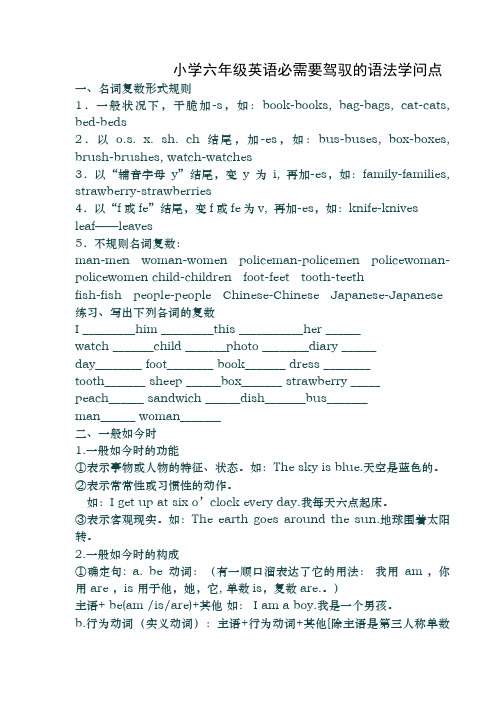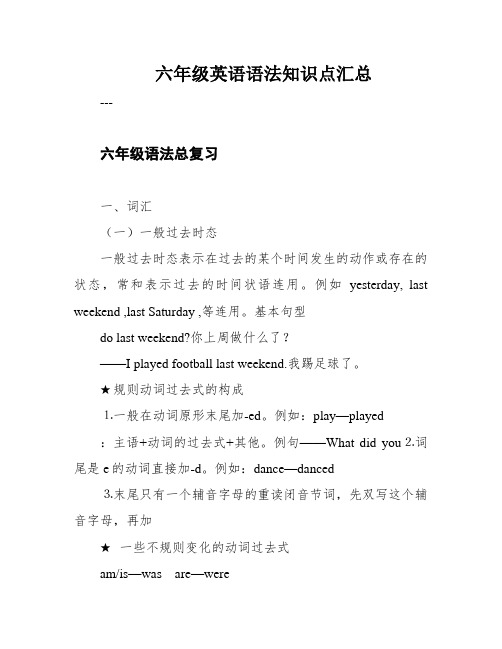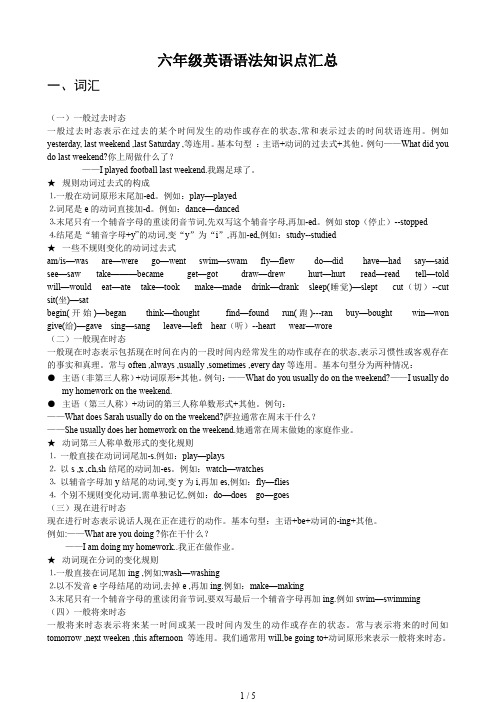六年级英语语法汇总
小学六年级英语必须要掌握的语法知识点

小学六年级英语必需要驾驭的语法学问点一、名词复数形式规则1.一般状况下,干脆加-s,如:book-books, bag-bags, cat-cats, bed-beds2.以o.s. x. sh. ch结尾,加-es,如:bus-buses, box-boxes, brush-brushes, watch-watches3.以“辅音字母y”结尾,变y为i, 再加-es,如:family-families, strawberry-strawberries4.以“f或fe”结尾,变f或fe为v, 再加-es,如:knife-knives leaf——leaves5.不规则名词复数:man-men woman-women policeman-policemen policewoman-policewomen child-children foot-feet tooth-teethfish-fish people-people Chinese-Chinese Japanese-Japanese 练习、写出下列各词的复数I _________him _________this ___________her ______watch _______child _______photo ________diary ______day________ foot________ book_______ dress ________tooth_______ sheep ______box_______ strawberry _____peach______ sandwich ______dish_______bus_______man______ woman_______二、一般如今时1.一般如今时的功能○1表示事物或人物的特征、状态。
如:The sky is blue.天空是蓝色的。
○2表示常常性或习惯性的动作。
如:I get up at six o’clock every day.我每天六点起床。
六年级英语语法知识点汇总

六年级英语语法知识点汇总---六年级语法总复习一、词汇(一)一般过去时态一般过去时态表示在过去的某个时间发生的动作或存在的状态,常和表示过去的时间状语连用。
例如yesterday, last weekend ,last Saturday ,等连用。
基本句型do last weekend?你上周做什么了?——I played football last weekend.我踢足球了。
★规则动词过去式的构成⒈一般在动词原形末尾加-ed。
例如:play—played:主语+动词的过去式+其他。
例句——What did you⒉词尾是e的动词直接加-d。
例如:dance—danced⒊末尾只有一个辅音字母的重读闭音节词,先双写这个辅音字母,再加★一些不规则变化的动词过去式am/is—was are—weresee—sawtake—tookread—read觉)—slept-ed。
例如stop(截止)--stopped⒋结尾是“子音字母+y”的动词,变“y”为“i”,再加-ed,例如:study--studiedgo—wentcome—cameswim—swam fly—flewbecome—becamedo—didget—gothave—haddraw—drewsay—saidhurt—hurtsleep(睡win—wontell—toldwill—wouldeat—ate take—tookcut(切)--cutsit(坐)—satthink—thoughtfind—foundmake—made drink—drankrun(跑)---ranwear—worebegin(入手下手)—beganbuy—boughtgive(给)—gave sing—sang(二)普通目前时态leave—left hear(听)--heart普通目前时态透露表现包孕目前工夫在内的一段工夫内经常发生的举措或存在的状况,透露表现习气性或客观存在的究竟和谬误。
六年级英语语法知识点汇总.doc

六年级英语语法知识点汇总六年级英语语法知识点11. 现在进行时表示正在发生的事情或进行的动作,常与now,listen,look 等词连用,结构是主语+be动词(am, is, are)+动词ing.如:It is raining now.外面正在下雨It is six o clock now.现在6点了My parents are reading newspapers in the sitting room.我父母正在客厅看报纸Look! The children are having a running race now.看!孩子们正在赛跑问句将be动词移前,否定句在be动词后+not.2. 一般现在时表示经常反复发生的事情或动作,常与often, usually, sometimes, always, every day(week year ) on Sundays等词连用。
结构是主语+动词原形;当主语为第三人称单数即he,she, it, Tom, my mother, the boy等词时,动词后加s或es.如:We have an English lesson every day.我们每天都要上英语课Do the boys run faster than the girls? Yes, they do.男孩比女孩跑的快吗?是的问句借助于do, does否定句借助于don t, doesn t,后面动词一定要还原。
3. 一般过去时表示发生在过去的事情或存在的状态,常与just now; a moment ago; ago; yesterday; last ( week; month; year; Monday; weekend); this morning等词连用。
结构是主语+be动词的过去式(was; were)或主语+动词的过去式。
注意:be动词与动词过去式不可同时使用。
如:My earphones were on the ground just now.我的耳机刚刚还在呢。
六年级英语语法知识点汇总

六年级英语语法知识点汇总一、词汇(一)一般过去时态一般过去时态表示在过去的某个时间发生的动作或存在的状态,常和表示过去的时间状语连用。
例如yesterday, last weekend ,last Saturday ,等连用。
基本句型:主语+动词的过去式+其他。
例句——What did you do last weekend?你上周做什么了?——I played football last weekend.我踢足球了。
★规则动词过去式的构成⒈一般在动词原形末尾加-ed。
例如:play—played⒉词尾是e的动词直接加-d。
例如:dance—danced⒊末尾只有一个辅音字母的重读闭音节词,先双写这个辅音字母,再加-ed。
例如stop(停止)--stopped⒋结尾是“辅音字母+y”的动词,变“y”为“i”,再加-ed,例如:study--studied★一些不规则变化的动词过去式am/is—was are—were go—went swim—swam fly—flew do—did have—had say—said see—saw take———became get—got draw—drew hurt—hurt read—read tell—told will—would eat—ate take—took make—made drink—drank sleep(睡觉)—slept cut(切)--cut sit(坐)—satbegin(开始)—began think—thought find—found run(跑)---ran buy—bought win—won give(给)—gave sing—sang leave—left hear(听)--heart wear—wore(二)一般现在时态一般现在时态表示包括现在时间在内的一段时间内经常发生的动作或存在的状态,表示习惯性或客观存在的事实和真理。
完整版)六年级英语语法知识点汇总

完整版)六年级英语语法知识点汇总六年级语法总复一、词汇一)一般过去时态一般过去时态表示在过去的某个时间发生的动作或存在的状态,通常与表示过去的时间状语连用,如yesterday。
last weekend。
last Saturday等。
基本句型为:“主语+动词的过去式+其他”。
例如:“What did you do last weekend?”,“I played football last weekend.”规则动词过去式的构成1.一般在动词原形末尾加-ed,如play—played。
2.词尾是e的动词直接加-d,如dance—danced。
3.末尾只有一个辅音字母的重读闭音节词,先双写这个辅音字母,再加-ed,(停止)ped。
4.结尾是“辅音字母+y”的动词,变“y”为“i”,再加-ed,如study--studied。
一些不规则变化的动词过去式am/is—was,are—were,see—saw,take—took,read—read,sleep(睡觉)—slept,go—went,come—came,swim—swam,fly—flew,e—became,do—did,get—got,have—had,draw—drew,say—said,hurt—hurt,win—won,tell—told,will—would,eat—ate,cut(切)--cut,sit(坐)—sat,think—thought,find—found,make—made,drink—drank,run(跑)—ran,wear—wore,begin(开始)—began,buy—bought,give(给)—gave,sing—sang。
二)一般现在时态一般现在时态表示包括现在时间在内的一段时间内经常发生的动作或存在的状态,表示惯性或客观存在的事实和真理,通常与often。
always。
usually。
sometimes。
六年级英语语法总结

六年级英语语法总结一、动词时态1. 现在进行时定义:表示现在正在进行的动作或存在的状态。
结构:be动词(am/is/are)+动词的现在分词形式(-ing)。
例句:I am doing my homework. 我正在做作业。
2. 现在完成时定义:表示过去发生的动作对现在造成的影响或结果。
结构:have/has+动词的过去分词形式(-ed)。
例句:I have finished my homework. 我已经完成了作业。
3. 一般过去时定义:表示过去某个时间发生的动作或存在的状态。
结构:动词的过去式。
例句:I did my homework yesterday. 我昨天做了作业。
二、名词1. 可数名词和不可数名词可数名词:可以计数的名词,如book(书)、apple(苹果)。
不可数名词:无法计数的名词,如water(水)、milk(牛奶)。
2. 名词的复数形式大多数名词的复数形式是在词尾加上s或es,如books、apples。
三、代词1. 人称代词:表示人称的代词,如I(我)、you(你)、he(他)、she(她)。
2. 物主代词:表示所有关系的代词,如my(我的)、your(你的)、his(他的)、hers(她的)。
四、形容词和副词1. 形容词:用来描述名词或代词的性质或特征,如red(红色的)、big(大的)。
2. 副词:用来描述动词、形容词或其他副词的程度或方式,如slowly(慢慢地)、quickly(快速地)。
五、介词1. 表示时间的介词:如in(在...里)、on(在...上)、at(在...点)。
2. 表示位置的介词:如in(在...内)、on(在...上)、at(在...处)。
六、定冠词和不定冠词1. 定冠词:表示特指,如the(这个)、that(那个)。
2. 不定冠词:表示泛指,如a(一个)、an(一个)。
七、句式结构1. 陈述句:陈述一个事实或观点,如I am a student.(我是一个学生。
小学六年级英语语法及词汇汇总

B y一、人称代词二、指示代词三.疑问代词四、不定代词五、数字和日期一、词类:1、 动词:行为动词、be 动词、情态动词。
(1)行为动词原形、+s/es 、+ed 、+ing ,具体判断方法如下: (2)be 动词a 、Am--was Is --was Are--were 口诀:我用am, 你用are, is 用在他她它,所有复数全用are 。
b 、肯定和否定句I am (not) from London. He /She is(not) a teacher. My hair is(not) long. Her eyes are(not) small.c 、 一般疑问句 Am I …? Yes, you are. No, you aren’t. Are you/they…? Yes,we/ they are. No,we/ they aren’t. Is the cat fat? Yes, it is. No, it isn’t.is 、am 、are 为一类,一般用于一般现在时、现在进行时和一般将来时中。
was 和were 为另一类,一般用于一般过去时。
(3)情态动词can 、must 、should 、would 、may 。
情态动词后动词总是用原形。
(不受其他任何条件影响) 2、 名词这里强调两点:不可数名词都默认为单数,所以总是用is或者was 。
如何加后缀:a .一般情况下,直接加-s ,如:book-books, bag-bags, cat-cats, bed-bedsb .以s. x. sh. ch 结尾,加-es ,如:bus-buses, box-boxes, brush-brushes, watch-watchesc .以“辅音字母+y”结尾,变y 为i, 再加-es ,如:family-families, strawberry-strawberriesd.以“f或fe”结尾,变f或fe为v, 再加-es,如:knife-knivese.不规则名词复数: man-men, woman-women, policeman-policemen, policewoman-policewomen, mouse-mice child-children foot-feet ,.tooth-teeth fish-fish, people-people,Chinese-Chinese, Japanese-Japanese3、形容词(包括副词)形容词表示某一事物或的特征,副词表示某一动作的特征。
英语所有语法知识点六年级

英语所有语法知识点六年级一、动词时态1. 一般现在时:用于表示经常性或普遍性的动作、情况或状态例句:I play football every Sunday.2. 一般过去时:用于表示过去某个时间发生的动作或状态例句:She watched a movie yesterday.3. 一般将来时:用于表示将来要发生的动作或情况例句:I will visit my grandparents next week.4. 进行时态:用于表示正在进行的动作例句:They are eating lunch now.5. 完成时态:用于表示已经完成的动作或状态例句:He has finished his homework.二、名词1. 可数名词与不可数名词例句:There are three apples on the table. (可数名词) I want some water. (不可数名词)2. 单数名词与复数名词例句:The dog is cute. (单数名词)The dogs are playing in the park. (复数名词)3. 名词所有格例句:Tom's book is on the table.三、形容词与副词1. 形容词用于修饰名词,表示名词的性质、特征或状态例句:She has a beautiful flower.2. 副词用于修饰动词、形容词或副词,表示方式、程度或时间等例句:He runs quickly.四、冠词1. 不定冠词(a/an)用于泛指单数可数名词前例句:I see an apple.2. 定冠词(the)用于特指或泛指某个人或物例句:The cat is on the table.五、代词1. 主格代词用于作主语例句:She is my friend.2. 宾格代词用于作宾语例句:He gave me a present.3. 物主代词表示所属关系例句:This is his book.六、介词1. 介词用于表示位置、时间、原因、方式等例句:He is in the park.2. 一些常见介词:in, on, at, with, for, to 等七、连词1. 并列连词用于连接同等重要的词、短语、句子等例句:I like apples and oranges.2. 从属连词用于引导从句例句:She is happy because she won the game.八、疑问词1. 疑问词用于构成疑问句例句:Where is the book?九、形容词比较级与最高级1. 形容词比较级用于表示两者之间的比较例句:She is taller than her sister.2. 形容词最高级用于表示三者或三者以上的比较例句:She is the tallest girl in the class.十、情态动词1. 情态动词用于表示能力、可能性、许可等例句:I can swim.十一、直接引语与间接引语1. 直接引语直接引述别人的原话例句:He said, "I am happy."2. 间接引语是对别人的话进行转述例句:He said he was happy.以上是六年级英语的所有语法知识点,掌握这些知识将会帮助你更好地理解和运用英语语法。
- 1、下载文档前请自行甄别文档内容的完整性,平台不提供额外的编辑、内容补充、找答案等附加服务。
- 2、"仅部分预览"的文档,不可在线预览部分如存在完整性等问题,可反馈申请退款(可完整预览的文档不适用该条件!)。
- 3、如文档侵犯您的权益,请联系客服反馈,我们会尽快为您处理(人工客服工作时间:9:00-18:30)。
六年级英语语法知识汇总一、词类:1、动词:行为动词、be动词、情态动词。
(1)行为动词原形、+s/es、+ed、+ing,具体判断方法如下:(2)be动词a、Am--was Is --was Are--were 口诀:我用am, 你用are, is用在他她它,所有复数全用are。
b、肯定和否定句I am (not) from London. He /She is(not) a teacher. My hair is(not) long. Her eyes are(not) small.c、一般疑问句Am I …? Yes, you are. No, you aren’t. Are you/they…? Yes,we/ they are. No,we/ they aren’t. Is the cat fat? Yes, it is. No, it isn’t.is、am、are为一类,一般用于一般现在时、现在进行时和一般将来时中。
was和were为另一类,一般用于一般过去时。
(3)情态动词can、must、should、would、may。
情态动词后动词总是用原形。
(不受其他任何条件影响)2、名词这里强调两点:不可数名词都默认为单数,所以总是用is或者was。
如何加后缀:a.一般情况下,直接加-s,如:book-books, bag-bags, cat-cats, bed-bedsb.以s. x. sh. ch结尾,加-es,如:bus-buses, box-boxes, brush-brushes, watch-watchesc.以“辅音字母+y”结尾,变y为i, 再加-es,如:family-families, strawberry-strawberriesd.以“f或fe”结尾,变f或fe为v, 再加-es,如:knife-knivese.不规则名词复数:man-men, woman-women, policeman-policemen, policewoman-policewomen, mouse-mice child-children foot-feet ,.tooth-teeth fish-fish, people-people, Chinese-Chinese, Japanese-Japanese3、形容词(包括副词)形容词表示某一事物或的特征,副词表示某一动作的特征。
形容词和副词只有两种形式:原形和+er。
未作比较的情况下就用原形,比较时就+er。
两个重要特征:as……as中间一定用原形,有than的时候一定+er。
人称代词:有主格和宾格之分。
一般动词前用主格,动词后用宾格。
物主代词:有两类:形容词性物主代词(短的)和名词性物主代词(长的)一般看后面有没有名词,如有,就用形容词性物主代词(短的);如无,就用名词性物主代词(长的)。
5、数量词:我们学过两类:基数词和序数词。
基数用于表示数量多少,而基数词用于表示次序,常在日期中出现。
序数词的前面一般都加the。
6、冠词:有a、an、the。
a和an的区别:an用于元音音素(一般就是元音字母aeiou)前,a用于辅音音素前。
二、否定句:be动词(am、is、are、was、were)+not、情态动词(can、must、should)+ not、助动词(do、does、did)+ not如何将一个肯定的陈述句改为否定句:1、看句中有无be动词,如有,直接在be动词后+ not。
2、看句中有无情态动词,如有,直接在情态动词后+ not。
3、如上述二者都没有,就应用助动词+ not。
分四个步骤:(1)肯定陈述句中本来是没有助动词的,要加上去,位置在主语(某人或某物)后,动词前。
(2)确定助动词用do、does还是did,根据句中动词,动词是原形的助动词就用do,动词是第三人称单数的助动词就用does,动词用过去式的助动词就有did。
(3)在助动词后加not。
(4)原句中动词假如发生变化就要恢复成原形。
强调一点,有some的要考虑是否要用any。
三、一般疑问句。
如何将一个肯定的陈述句改为否定句:1、看句中有无be动词,如有,把be动词提到句首即可。
2、看句中有无情态动词,如有,把情态动词提到句首即可。
3、如上述二者都没有,就应把助动提到句首。
分四个步骤:(1)肯定陈述句中本来是没有助动词的,要加上去,位置在主语(某人或某物)后,动词前。
(2)确定助动词用do、does还是did,根据句中动词,动词是原形的助动词就用do,动词是第三人称单数的助动词就用does,动词用过去式的助动词就有did。
(3)把助动词后提到句首。
(4)原句中动词假如发生变化就要恢复成原形。
强调一点,有some的要考虑是否要用any。
四、特殊疑问句。
表示疑问,有疑问词(在开头),回答有很多种可能。
常用疑问词:肯定祈使句一定是以动词原形开头(有时有please),否定的祈使句一定是don’t加动词原形开头(有时有please)。
把祈使句改为否定句只需在动词前加don’t即可。
六、时态1、一般现在时(1)一般现在时中的be动词:一般用原形:am is aream用于第一人称单数(I);is用于第三人称单数(he she it和其他人名或称谓,如:Ben his sister等);are用于第二人称单数(you)和所有复数(包括第一人称复数we、第二人称复数you;第三人称复数they和其他复数,如the children 、his parents等)。
(2)一般现在时中的动词:第一种情况:主语是第三人称单数(he she it 和其他,如Helen 、her cousin 等),动词后一般加s或es。
第二种情况:主语不是第三人称单数,动词都用原形。
(4)一般现在时判断依据(如何判断一个句子是一般现在时):△be动词是am、is、are△动词用原形或加s、es△没有时间状语或有usually、often、everyday、sometimes等不是具体的时间2、一般过去时(1)一般过去时中的be动词:一般用过去式:was werewas用于第一人称单数(I)和第三人称单数(he she it和其他人名或称谓,如:Ben 、his sister 等);were用于第二人称单数(you)和所有复数(包括第一人称复数we、第二人称复数you;第三人称复数they和其他复数,如the children 、his parents等)。
(2)一般过去时中的动词:一般只有一种情况:+ed这里强调一点,和一般现在时不同的是这里不管主语是第几人称,也不管是单数和复数都加ed。
(4)一般过去时判断依据(如何判断一个句子是一般过去时):△be动词是was、were △动词加ed△有表示过去的时间状语现在学过的常用的表示过去的时间状语有:just now a moment ago yesterday last week last nightlast weekend last year last month three days ago two weeks agofive years ago this morning3、一般将来时(1)构成形式:Be going to +动词原形, will + 动词原形(2)一般将来时表示动作即将发生或某人打算做某事。
(3)句中往往有tomorrow、soon、next week等词。
4、现在进行时(1)构成形式:Be动词+动词的ing形式这里强调一点,两者缺少其中任何一种都不可以构成现在进行时。
(2)现在进行时表示动作正在进行或事情正在发生。
(3)有用的依据:一个句子中既有be动词,又有动词,且动词加了ing ←→该句是现在进行时(4)句中往往有now、look、listen等词。
动词过去式、现在分词的不规则变化:be 是——was, were——being begin 开始——began——beginning build 建筑——built——building buy 买——bought——buyingcan 能——could——无come 来——came——coming copy 拷贝——copied——copying do 做——did——doingdraw 画——drew——drawing drink 喝——drank——drinking drive 驾车——drove——driving eat 吃——ate——eatingfeel 感觉——felt——feelingfind 找寻——found——findingfly飞——flew——flyingforget 忘记——forgot——forgetting get 得到——got——gettinggive 给予——gave——givinggo 去——went——goinggrow 成长——grew——growinghave 有——had——havinghear 听——heard——hearingkeep 保持——kept——keepingknow 知道——knew——knowinglearn学习—learnt, learned——learning let 让——let——lettingmake 做——made——makingmay 可以——might——无mean 意思——meant-meaningmeet 见面——met——meetingmust 必须——must——无put 放——put——puttingread 读——read——readingride 骑——rode——ridingring 响——rang——ringingrun 跑——ran——runningsay 说——said——sayingsee 看见——saw——seeingsing 唱歌——sang——singingsit 坐——sat——sittingsleep 睡觉——slept——sleeping speak 讲话——spoke——speaking spend 花钱——spent——spending stand 站立——stood——standing sweep 打扫——swept——sweeping swim 游泳——swam——swimming take 拿到——took——takingteach 教——taught——teachingtell 讲述——told——tellingthink思考——thought——thinkingwill 意愿——would——无write 写——wrote——writing小升初英语考试,必须要掌握的英语语法知识点(一)一、名词复数规则1.一般情况下,直接加-s,如:book-books, bag-bags, cat-cats, bed-beds2.以s. x. sh. ch结尾,加-es,如:bus-buses, box-boxes, brush-brushes, watch-watches3.以“辅音字母y”结尾,变y为i, 再加-es,如:family-families, strawberry-strawberries4. 以“ f 或fe ”结变f 或fe为v , 再加-es如:knife-knives Leaf——leaves5.不规则名词复数:man-men, woman-women, policeman-policemen, policewoman-policewomen, child-childrenfoot-feet,.tooth-teeth6.单复数同形的名词:fish-fish, people-people, Chinese-Chinese, Japanese-Japanese写出下列各词的复数I _________him _________this ___________her ______watch _______child _______photo ________diary ______day________ foot________ book_______ dress ________tooth_______ sheep ______box_______ strawberry _____peach______ sandwich二、行为动词的变化。
